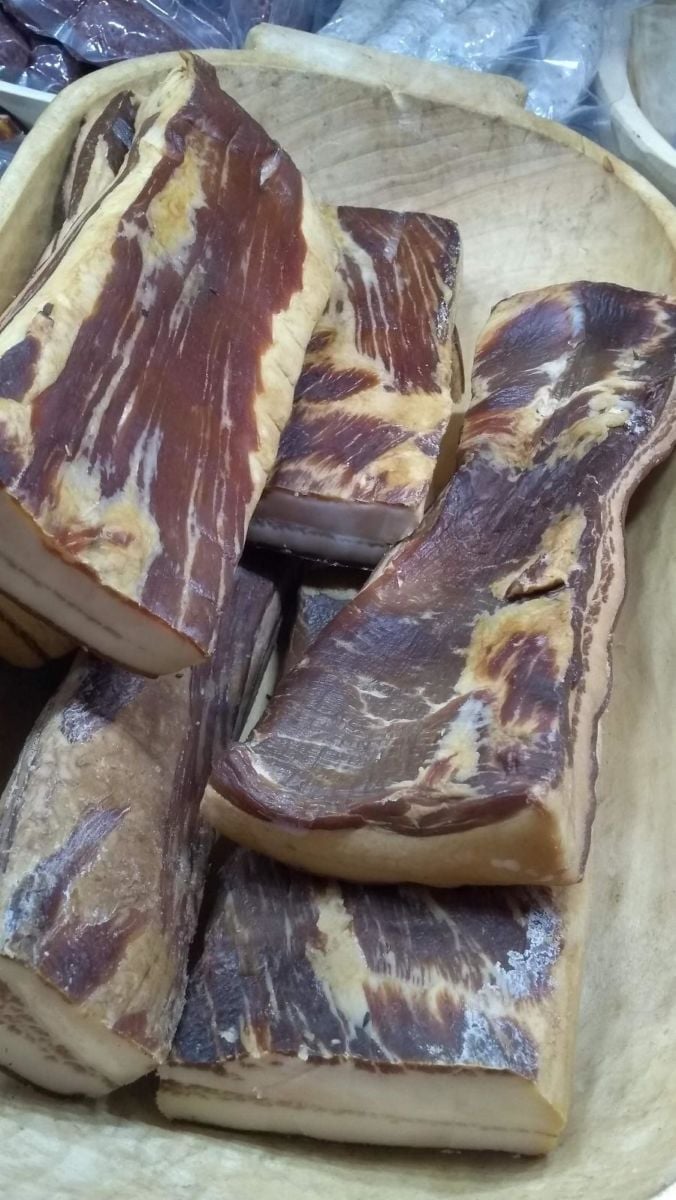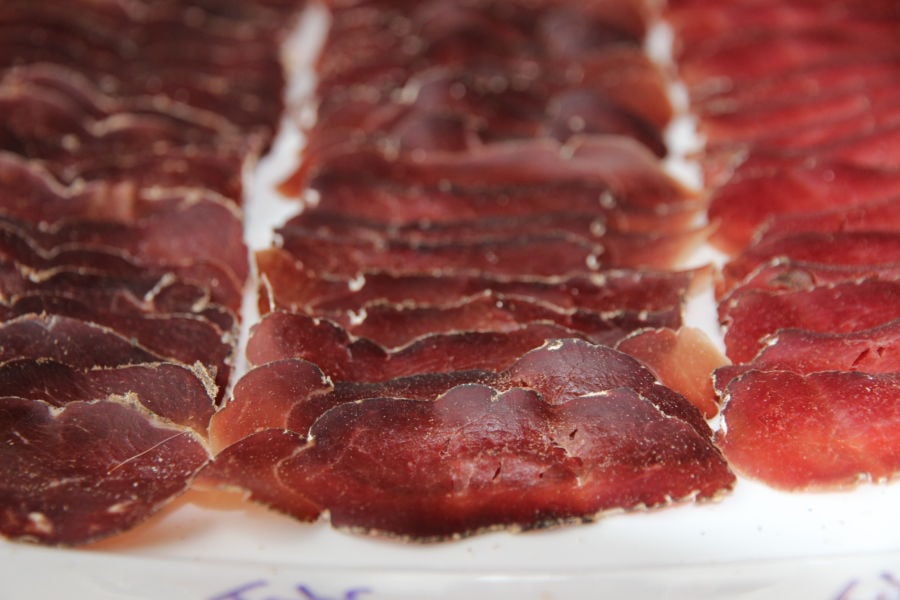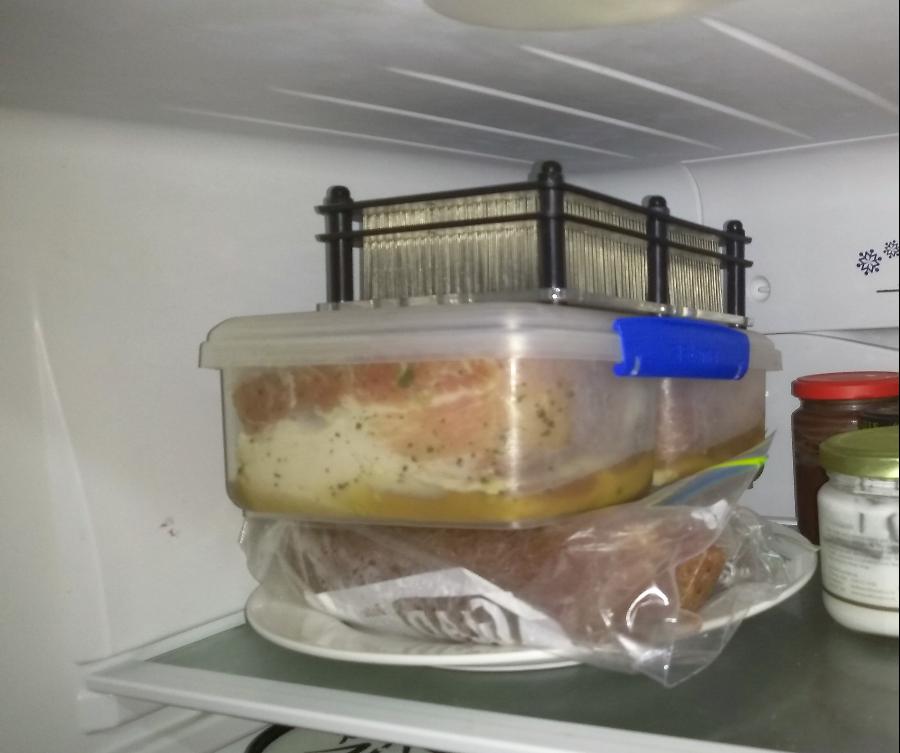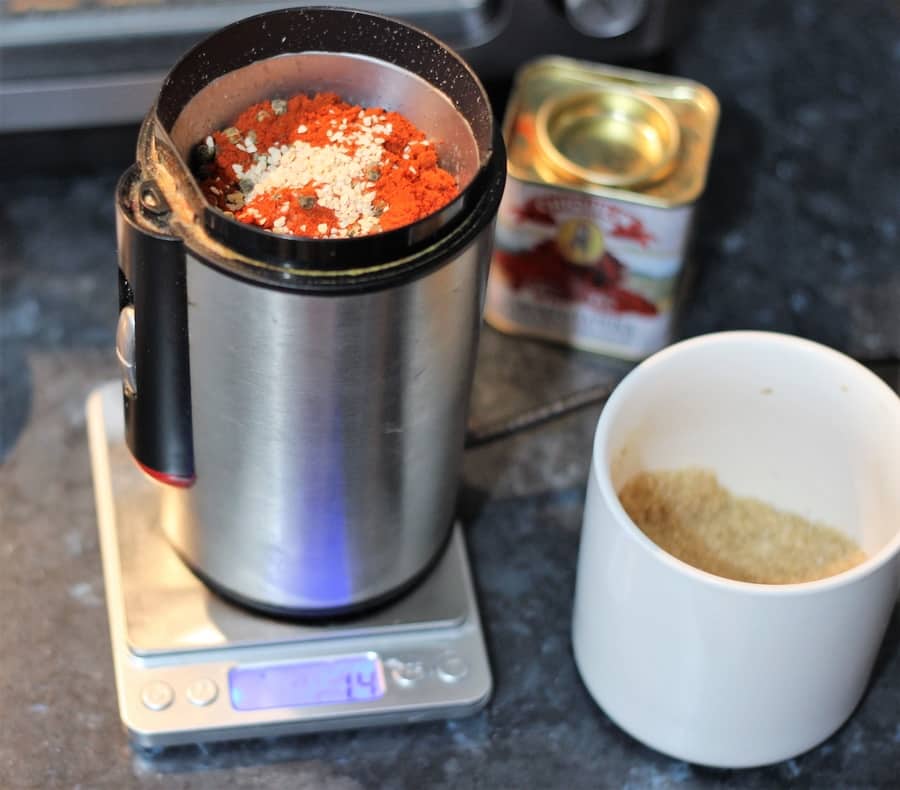This equilibrium curing guide will cover everything I’ve learned and know in a few decades of studying meat curing.
It’s the primary method I use due to the consistency and flexibility it can provide in curing meat.
Guide to Equilibrium Curing
The beauty of equilibrium curing with either wet brine or dry cure is consistent salt flavor levels. If you use a minimum percentage of salt and follow the process, you will create solid outcomes. You will consistently have great results if you have cured the meat long enough.
What is Equilibrium Curing?

Equilibrium curing – using a percentage of salt to the weight of the meat. (You can also use a percentage of the weight to work out the volume of water if you are wet brining.)
Ie.
2.5% sea salt = 1,000 grams meat
0.025 x 1000 = 25 grams of sea salt
Pretty simple! Using the metric system with grams and kilograms is much easier than using the Imperial system.
Be careful when calculating decimals; that’s also why the calc link is good to use.
How is Equilibrium Curing Meat Different from Salt Box Excess?
The old method of saltbox or saturation involves covering the meat entirely with salt. This method uses a lot of salt.
I still use this method for large meat muscles or making salt pork.
Things like salt beef, fish & salt pork fall into this category.
I like to use 2% salt at minimum for dry curing whole muscle meat like salumi. This often includes the 0.25% pink curing salt 1 or 2.
I think the saturation methods of salt curing make a lot of sense if you’re using the whole leg for something like prosciutto or multiple 20-lb slabs of pork belly for bacon, for instance—I’m talking huge muscles.
Why Use It

As mentioned above, and as you probably already know, it’s more efficient to use less salt.
Equipment needed: precise, accurate scales to measure the amount. I’m talking about one or, ideally, two decimal places (i.e., 0. x or 0. xx). This is also because so many recipes in almost all my cooking books have a volume amount.
Like 1 cup of this and three tablespoons of that.
For instance, all the different brands and types of salt take up different amounts of volume and, therefore, can weigh different amounts. Using volume for consistency in the kitchen for many recipes is a far superior way, but cups and teaspoons are still the generally accepted norm.
Curing Time
Length of Time to Cure
Factors that influence include:
The amount of fat present
Temperature
Salt Concentration
My general rule is one week per 2 inches (50mm) of the meat’s thickness for Equilibrium Curing.
But if you have genuinely removed all the air/oxygen from the curing bag, then you could leave a piece of meat in the fridge for an additional 1-2 weeks without affecting it.
Equilibrium Curing – The curing will wait for you, not the other way around, like with traditional saturation or excess salt methods.
My equilibrium cure calculator is located at the top of each web page.
How long you leave something in the cure varies, but it’s more forgiving with equilibrium curing.
I did quite a small chunk of pork belly to make cold-smoked bacon last week using equilibrium curing.
One week is enough for 2 pounds/1000 grams of pork belly.
But I also like to add a bit of weight; this time, it was an antique clothes iron I found lying around. This helps push the cure into the meat; I often use cans of food.
What Can it be Used For
Equilibrium curing is primarily used to make dry-cured meat of the whole muscle variety.
Though it has applications for cooking, equilibrium measurements can also lead to more accurate outcomes for any food preparation—commercially, often more than volume-based measurements.

Dry & Wet Equilibrium Curing

From the community and the groups I’m part of, dry curing using equilibrium curing seems much more popular than wet brine equilibrium curing. Whenever you add brining to the recipes, you also dilute flavor.
My equilibrium curing calculator can calculate both approaches.
Dry curing creates a deeper and more pronounced taste from spices and aromatics. When using wet brining, everything seems a little bit smoother and subtler.
Process
Weigh the meat
Calculate the amount of salt and spices for the cure (and nitrates if applicable)
Calculate the water for the brine (if applicable)
Use accurate scales to measure out all the salt-cure ingredients
Use a bowl or container to massage and rub the cure mix thoroughly into the meat (no leftover cure, all added to the bag)
Place the meat in a bag with all the cure and remove air/oxygen
Place in the fridge or at a similar temperature.
- Apply weight to the bag for quick penetration if desired
Salt
Sea salt comes in many forms and sizes; many brands are on the market.

But when it comes to curing meat, you always want salt that doesn’t have additives. So, ideally, iodized salt or something like an anti-caking agent, which is pretty standard, should be avoided.
Rock salt verse fine sea salt measured by the cup will be a completely different weight, therefore, saltiness will vary greatly.
I use a spice grinder, like one of these (electric or manual) – it makes quick work of any salt or spice mix – and a kind of powder I find preferable for equilibrium curing my meat.
Essential Equipment for Equilibrium Curing

Digital Measuring Scales
Getting the degree of accuracy is the most important thing.
My partner bakes all sorts, especially sourdough, and her scales generally has an accuracy of + or – 2 grams, which is unacceptable for equilibrium meat curing.
Spice Grinder or Mortar & Pestle
TIP – If you have a small grinder, place it on your scales and just TARE Zero In as you add the ingredients.
You can get away with a mortar and pestle for crushing/mixing the cure, just a little arm workout needed. It takes much longer to get a finer salt and spice mix.
For many meat curing projects, a finer powder, which can be done in seconds with an electric spice (coffee) grinder, makes quick work of the job.
It is best to dedicate a spice grinder to meat curing; coffee beans can linger in the grinder!
The finer spice mix allows you to spread it across more areas of the meat. Sometimes, it may be perceived that you don’t have enough cure volume when equilibrium curing. You have to trust the calculations you have performed.
You cover all areas across the meat into every crevice you can find.
Container or Bowl
This seems pretty basic, but getting the right size container or bowl for your piece of meat helps.
My favorite method is to use a stainless steel mixing bowl, which is somewhat rounded. This means I can use the meat to wipe up every last bit of equilibrium cure from the bowl.
The example below illustrates this.

Airtight Bag
Equilibrium-curing can be done in a Ziploc bag, and as much air/oxygen as possible. Another standard method is to use a vacuum sealer/pak.
Another choice is to grade reusable silicone bags, which can also remove the air.
Spices & Flavoring Equilibrium Curing
This is probably the most exciting part of meat curing (category article link): the sweet smell of bay (leaf) laurel, the savory flavors of juniper berries, or maybe the various paprika of the world, along with delightful hints of ham. They can create entirely new flavor angles.
FAQs
What percentage of salt is needed for equilibrium curing?
For equilibrium curing, you typically need 2% to 3% salt based on the meat’s weight, ensuring proper preservation without excessive saltiness. This method allows for precise salt absorption, preventing over-curing while maintaining consistency in flavor and texture.
How did they cure meat in the old days?
In the old days, meat was cured using dry salt, brine, smoke, and air drying to preserve it without refrigeration. Salt was the primary method, drawing out moisture to prevent spoilage, while smoking added antibacterial properties and flavor. In colder climates, meats like prosciutto or bresaola were often air-dried, while warmer regions used heavy salting or fermentation techniques to ensure longevity.
What Can Equilibrium Curing be Used for?
Equilibrium curing is used for dry-cured meats, charcuterie, and certain brined products, allowing precise salt absorption for controlled preservation. It’s ideal for whole muscle cuts like coppa, bresaola, pancetta, and duck prosciutto, as well as brined items like bacon and pastrami, ensuring consistent flavor and texture without over-salting.
Please feel free to comment; I am always interested in anyone’s thoughts.

Tom Mueller
For decades, immersed in studying, working, learning, and teaching the craft of meat curing, sharing the passion and showcasing the world of charcuterie and smoked meat. Read More

Great writeup and intro to EQ. Thank you for sharing. I will be linking to this post from my webpage for those who are curious about EQ
Cheers Kjell, I enjoy harvesting a few animals too!
I don’t get this. If the meat is inside a airtight bag how it will dry out and loose 35% weight ?
Hey, stage one equilibrium curing in a bag. (curing is about using salt to inhibit the meat, slow down bacteria).
Stage two, hang and dry – this is where the weight loss occurs. Cheers Tom
And why in “Complete guide” there are zero words about stage two? Just salt, bag, 1 week per 1 pound?
its about curing, here is another page that might help – https://eatcuredmeat.com/how-to-cure-meat-at-home-complete-illustrated-guide/
I think the answer is that once its cured and removed from your cure, you’re done curing. the rest is aging and drying.
For a long time I cured the venison tenderloins using the excess salt method. I tried the equilibrium method on one of the deer this year (at the same time I’m doing the excess salt method), and It looks great so far.
One question though, the equilibrium cured piece seems to have lost moisture a WHOLE lot faster than the excess salt cured. Is that normal?
For the numbers –
Excess salt cure: packed in salt 8/24, left for 36 hrs, hung on 8/25.
Starting weight at hang – 87 g; target weight – 57 g.
Time to hit target weight -14 Days.
Equilibrium cure – seasoned and vaccuum sealed on 8/24. Pulled out of bag on 9/1 (7 days), rinsed and hung same day.
Starting weight at hang – 107 g; target weight – 70 g.
Time to hit target weight – seems to have only been about 6 days.
Does that look right to you?
Hey James,
Here’s my take on this.
Excess Salt / Saturation / Saltbox method = yes your drawing moisture out during the curing phase.
Equilibrium Curing is about precisely inhibiting the meat with salt, reducing water activity inside the meat by using salt to meld with the meat molecules. In a way it’s a wet brine (but done with precision)
the internal fat could also effect it, fat is slower to ‘dry’ out.
A bit of mystery, especially if you have used the precise temp/humidity in a chamber.
If it was me, I would just trust the weight lost target fo sure.
Cheers
Tom
Hi Tom, Thanks for a good overview of the options and for sharing your methods. I do equilibrium cures myself, and agree on the advantages. There might be a typo in this paragraph:
“But when it comes to curing meat, you always want to have salt that doesn’t have any additives. Non-iodized salt or any other thing like an anti-caking agent, which is pretty common should definitely be avoided.” Should it read “Iodized salt”. . . should be avoided? Thanks,
Cassandra
Thanks! Good luck with the curing!
Thinking and typing too fast sometimes! 🙂
Great information, I was using excess of salt method, getting salty meats, now will go into EQ method,
Thanks for all this valuable information
Nice work Gabriel, yeah its a game changer, if you want I also have launched whle muscle curing course course, more on this page
Cheers Tom
congratulations, interesting read. Is there a minimum amount of salt that needs to be respected? I find 2.25% (2% salt + 0.25% cure) produces a salty product. can I drop to 1.75% (1.50% + 0.25) or 2.00 % (1.75% + 0.25)safely?
Thanks! Personally I got min of 2% total with or without pink curing salt
Cheers
T
Hi Tom, Im a novice for sausage making. Today I got my stuffer and last couple of days Im only busy with reading all in and outs. Your EQ is a great article. Appreciate that.
Have one question: do you have an article which discribes the differences between curing salt #1 and#2?
Thanks in advance
Peter Beumer
Sure, here you go!
LINK to curing salt – more and more salami I am making doesn’t have nitrates/nitrites, but I control all other variables closely – ie fresh quality meat, exact salt, often cold smoking, ph/acidity control, winter/temps that are near fridge like!
Hello Tom,
Thank you for the great article. I’m still new to this hobby and have cured some bellies for Pancetta and a whole loin for Canadian Bacon. I’ve had great results. But to my taste they where very salty. I’m using the dry EQ method and using the standard 2.25% sea salt and 0.25% cure #1.
Is there anything scientific about these numbers?
Can I use less sea salt, say 1.85 and keep cure #1 the same?
Thanks again!
Hey there I’ve grown more fond these days of around 2%, if you were to use #1 that would be 1.75% sea salt and 0.25% #1.
I’ve been studying a lot of commercially dry cured product packaging and noticed 1.8g per 100 grams (1.8%…). But personally always do 2%+
All the best,
Tom
Do you have to cook the meat after these different methods, or does it depend on the type of meat? Im thinking rabbit, deer, trout. Ive started my first equilibrium cure last night with some slices of chicken, but I havent been able to find anything on line that says whether you can eat it after curing, or if it still has to be cooked, and if it still has to be cooked, how you cook the cured meat. Per method, of course.
Are you curing to dry or curing to cook? Chicken hold a lot of bacteria so I wouldn’t use it for dry curing. I have a course on this above at the top if you are wanting to dry curing meats. Deer I do a lot of, trout can be like salmon ie. a Gravlox style and rabbit I am not sure about – yet to try!
Hey Tom,
Great write up!!! Very informative. I do have a question about equilibrium curing a whole muscle that has a bone in it. Lets say a leg of lamb or something similar. How do you calculate the salt and cure % for situations like this?%
Thanks, I like your channel too 🙂
I stick to the total weight regardless of bone weight to work out %’s. Keep it simple I say.
Cheers
Tom
Do you blend the spices with the salt and then cure, or spice prior to drying?
Definitely salt and spices, then you can add a coating of spices like peppercorns or chili before hanging/drying if you want also.
Hi Tom, i just gave it a shot and have cold smoked the meat for 3 hours (after 9 days of curing).
the meat inside the smoking chamber is now all sweaty and wet.
Question:
should i pat dry it before placing back in my curing (wine) fridge ?
or
just put it in the fridge and leave all the moisture on it ?
Did you form a pellicle? What about ambient temp outside vs temp inside? I wont need to pat dry cold smoked meat, because I can’t recall it being sweaty and wet! all the best, Tom
Hello Tom,
I’m sorry to inform you I paid for your course and I can’t get into it, almost as if I was locked out. I paid you about 1 1/2 years ago for your course.
But you now, I’m wet curing a whole pork belly. 5.76kgs. I’m going with 1.80% salt. My question how long should I leave the belly soak submerged in the brine?
Thank you.
Hi Dale, I’ve sent you a reset via email.
It depends on what your making! T
hello, I followed your instructions for curing small cuts of pork using the equilibrium method and they turned out well. i want to try curing a full pork loin. i have a small curing chamber that is set to 52f and about 80% humidity. i also have successfully grown powdery white mold taken from a dry-cured ham and transplanted it onto the meats i’ve cured.
i have curing salts #1 and #2. i used #1 for the small cuts as you suggested in your article on using a fridge to cure. i’ve read that larger, longer-curing cuts should be cured with #2. would you suggest using #2 on a full pork loin? also, is it a good idea to tie the loin into a cylindrical shape with butcher’s twine? some of the recipes i’ve read for lonza/lonzino say to tie it up, but i don’t know if that’s just to make it look nice or if it has some practical purpose. if i do tie it up, do i do that after curing in the fridge and rinsing off the meat, or do i tie it up, then let it cure in salt, then rinse and hang?
thank you for your help. your website has lots of valuable information.
Heya, yes if you want to tie, I do this after curing. It’s mainly for shape, thats about it. Looks nice too. Cure #2 is if the project takes more then 30 days, since the nitrites break down to nitrates over the longer drying/curing period. Meat over 2.2pds/1kg generally takes more then 1 month to finish I find. Hope this helps, Tom
that’s very helpful. thank you. my first attempt at equilibrium curing turned out well. the white mold grew successfully and i got the weight down to about 50%. it ended up surprisingly delicious.
wish me luck with the full pork loin. if it’s as good as the little ones then i’m going to really get into this.
Travis Trout! Great name, all good. Glad to be of use. It’s a glorious skills and hobby! Tom
Please define small cut of meat – I wrote about smalls cuts dry curing here – https://eatcuredmeat.com/dry-curing/how-to-cure-meat-in-a-fridge-without-modifying-it/
under 1/2 pd, 250 grams